The Neanderthals lived in Andalucia from 500kya to about 45kya. Did the last of the Neanderthals meet modern humans?
By Nick Nutter | Updated 10 Aug 2023 | Andalucia | History |
Login to add to YOUR Favourites or Read Later
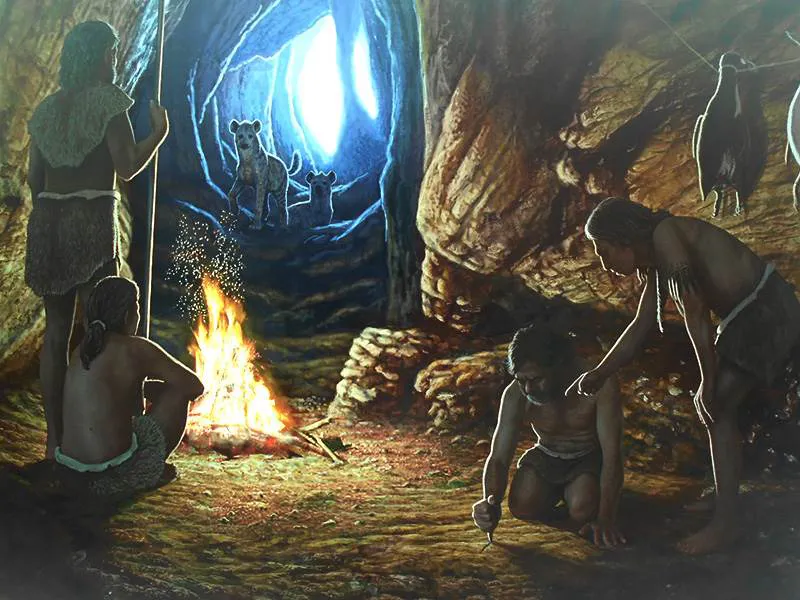
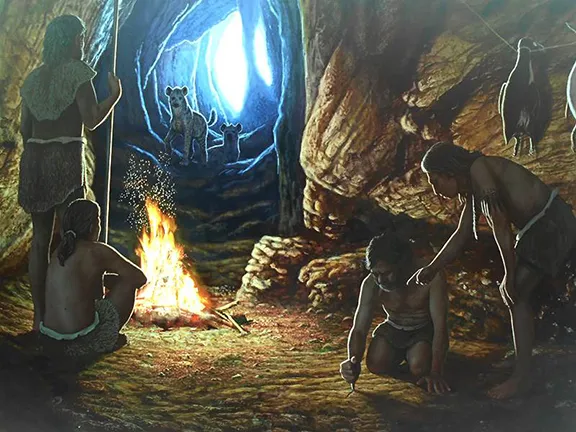
Neanderthal Cave
About 500 kya the ancestors of the Neanderthals arrived in the Iberian Peninsula. The common ancestor of Home neanderthalis and Homo sapiens is Home heidelbergensis who left Africa about 700 kya, following what was by then a well-trodden path through the Middle East. The DNA evidence suggests that they met and bred with earlier migrants and carried those genes with them to the Iberian Peninsula. In Europe Homo heidelbergensis evolved into Neanderthal, whilst in Africa Homo heidelbergensis evolved into Homo sapiens. It is important to remember that Homo sapiens, Homo neanderthalis and Home heidelbergensis are all variants of the same species. Remains of Homo heidelbergensis have been found at Atapuerca in northern Spain, dating back to about 500 kya.
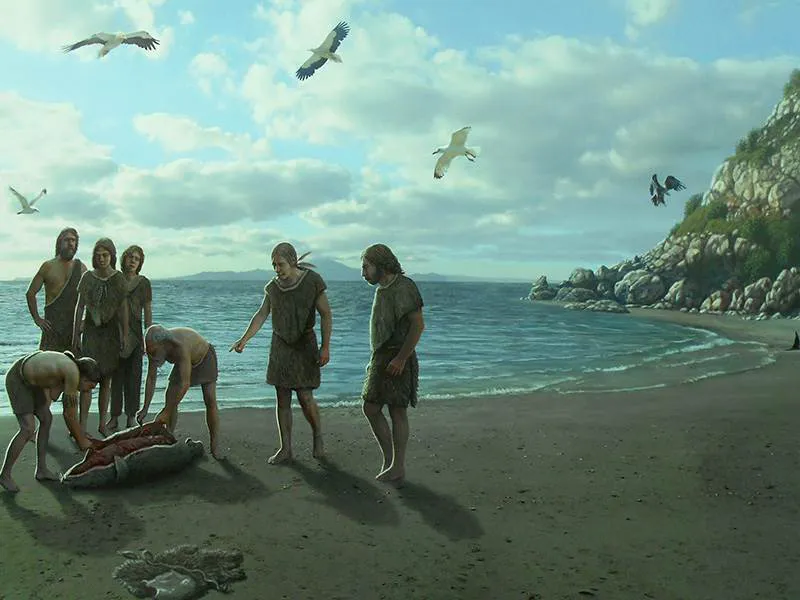
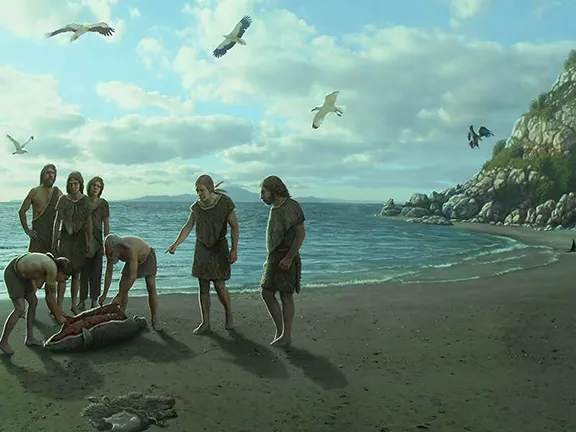
Neanderthal Beach Scene
In 2015, excavations began in the first cave site in Andalucia to provide evidence of very early human habitation, possibly up to 400 kya. Cueva del Angels near Lucena in Cordoba province has given us tools identified as Acheulian and a female femur dated to the same time period. Surprisingly these Homo heidelbergensis occupants were eating olives from about 300 kya. Cueva del Angels could be as important as Atapuerca.
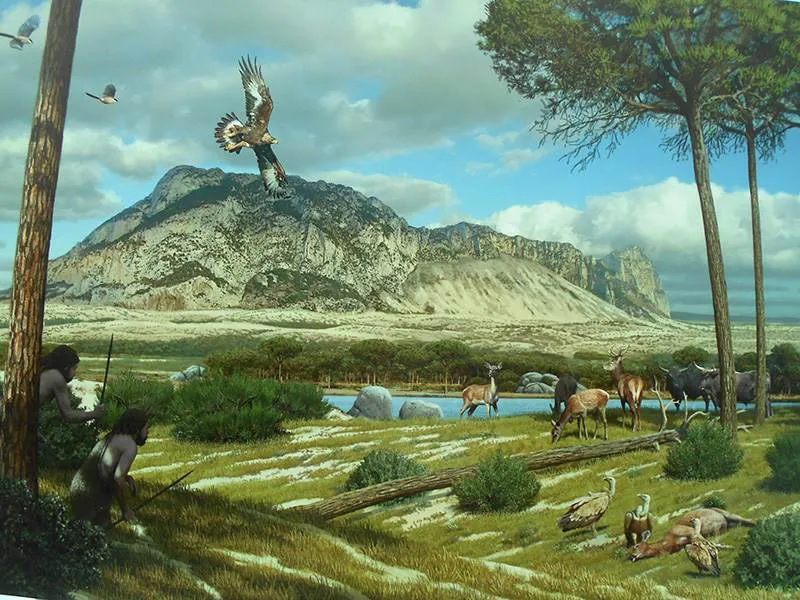
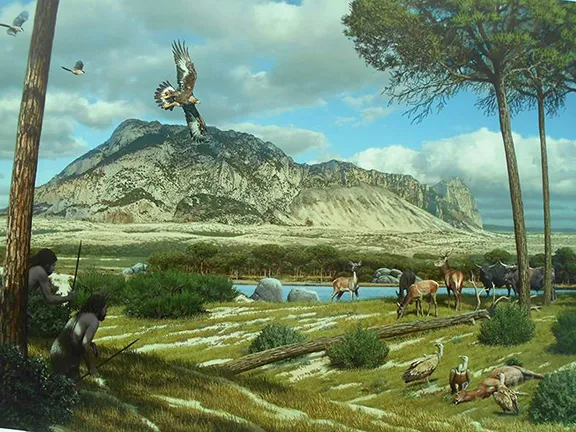
Gibraltar
Definite signs of the evolved Homo neanderthalis, his Mousterian toolkit, start to appear about 106 kya in northern Spain.
The Mousterian toolkit consists of hand axes, side scrapers and spear points. They were sometimes made by taking a stone and reducing it to a shape from which the finished tool could easily be struck off and thence require little finishing. The Levallois technique is a refinement of this method. Apart from being a better way of producing stone tools than anything that went before, the Levallois technique also demonstrates that Neanderthals could ‘see’ a finished article in a lump of stone, just as a sculptor can today.
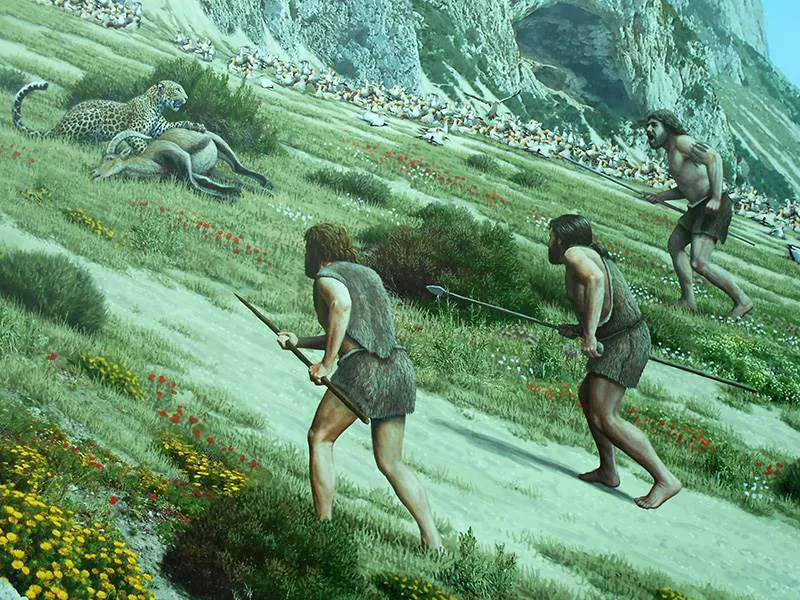
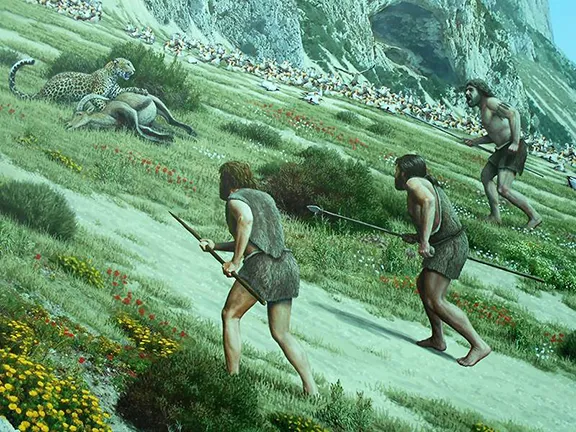
Neanderthals Hunting
Climatic conditions had started to deteriorate about 120 kya, reaching a glacial maximum about 22 kya, after which temperatures started to rise. During that 100,000 year period, the temperatures oscillated with periods of warmth interspersed with periods of intense cold. Vegetation, birds, animals and humans moved around to try to remain within their own comfort zones. Generally, movement was in a southwards direction during the onset of cold spells.
As a matter of interest, the last permanent ice from the last glaciation, on Mulhacen in the Sierra Nevada range - the highest mountain in Andalucia and the Iberian Peninsula, did not melt until the 1980s (AD).
The Neanderthals were a very successful group, weathering several extreme climatic changes. However, the Neanderthal reaction to climatic deterioration was to retreat, rather than adapt in situ. They were highly mobile. So, although evidence of Neanderthal activity can be found generously spread across the Iberian Peninsula, it may be assumed that such activity only occurred when the climate was reasonably clement in that area. An example may be found at Los Casares, a cave situated in the interior of the Iberian Peninsula between Madrid and Zarragoza. Between 42,899 BC and 40,175 BC, the cave was occupied by Neanderthals during a relatively warm and humid episode. The weather deteriorated and, archaeologically, the Neanderthal record disappeared. Los Casares provides the last record of Neanderthals in the interior of the peninsula.
The next record of human habitation at Los Casares appears in the form of cave art created by modern man dated to between 23,000 and 13,000 years ago. Later, we shall see that this retreat strategy did not help Neanderthal survival after modern humans arrived on the scene.
There are approximately 20 sites in the Iberian Peninsula with evidence of a Neanderthal presence. Older finds tend to be in the north of the Peninsula. In 2018, researchers working at a site in Barrika, on the Biscay coast, discovered waterlogged wooden tools, including a 15 cm long digging stick dating to 90 kya. The point had been hardened by heating it. Wooden artefacts from this period are very rare because wood degrades quickly. Remains are normally only found in waterlogged sediments.
Their remains or evidence of their presence, normally Mousterian stone tools, or art of sufficient antiquity that it can be nothing other than Neanderthal, have been found in Andalucia at Ardales Caves in Malaga province (art dated 65.5 kya – 45 kya), Carihuela Cave in Granada province (Mousterian tools dated 51,000 to 23 kya), and in Gorhams Cave at Gibraltar (where there are occupation layers from 100 kya to 30 kya). The latest dated find in the whole of Europe is a mandible from a Neanderthal, found in Cueva del Boquete at Zafarraya in Granada province that was dated to 30 kya. Tools of the Mousterian type were also found dating to as late as 27 kya. An ambiguous date of 42 kya for paintings in Nerja cave may also indicate a Neanderthal presence there.
The last well-dated Neanderthal remains in Cantabrian Spain are the cannibalised individuals from El Sidrón Cave in Asturias, 48 – 49 kya. Cannibalisation is a sign of severe stress within a society. Remains from a similar age occur on the south side of the Cantabrian Cordillera in Valdegoba (Burgos). The last Mousterian artefacts at El Castillo in Cantabria, L’Arbreda and Romani in Catalunya (on the Mediterranean coast in the Barcelona area), seem to date from 44 – 43 kya between Heinrich events 5 and 4.
In southern Spain, outside of Andalucia, Neanderthals from Sima de la Palomas de Cabezo Gordo in Murcia, date to between 43 and 40 kya and in Cueva Anton at Mula, again in Murcia, to 36 kya.
In Portugal it is acknowledged that the several sites in central and southern Portugal have evidence of Mousterian assemblages with dates between 39 and 34 kya that require recalibration. In 2020, a research team from the University of Barcelona, announced they had found evidence of Neanderthal’s eating seafood in a known Neanderthal cave site, Figueira Brava.
Figuera Brava is on the coast at the foot of the Arrabida uplands, west of Sesimbra, between Alpertuche and Portinho da Arrabida. Researchers report that about 50% of the diet, based on the remains of animals, birds and fish, was composed of mussels, crabs, seabirds and fish including sharks, eels, sea bream, dolphins and seals. The other half were the remains of deer, goats, horses, aurochs and tortoises. What is remarkable is the age attributed to the remains, between 106 and 86 kya, making this find one of the earliest Neanderthal sites in the Iberian Peninsula. The cave is now at the water’s edge, at the time it was occupied the coast would have been about 2 kilometres inland.
Exploitation of seafood by Neanderthals was also reported from Gorham’s Cave and Vanguard Cave in Gibraltar. In Vanguard Cave, a layer of ash and mussel shells indicated Neanderthals were cooking their seafood, probably using heat to open the shells. At lower levels, amongst the bones of ibex, red deer, wild boar and cave bears, were the remains of monk seals, bottlenose dolphins, and short beaked dolphins, seabream, tortoise and birds. The remains from Vanguard are dated between 70 and 39 kya. Remains from Gorham’s Cave are more accurately dated to between 32 and 30 kya and include earless seals. Interestingly, at the Gibraltar sites, archaeologists found the remains of Stephanorhinus, a now extinct rhinoceros that stood over 2 metres tall.
The Neanderthal environment at Gibraltar is one of the most researched in the world and now provides an accurate picture of Neanderthal life. In 2016, the cave complex and the slope behind, up to the top of The Rock, were declared a World Heritage Site.
32kya, the last of the Neanderthals in Europe died at Gibraltar. It would be 4,000 years before another human set eyes on the same view, a view quite different to that of today. For much of the time that Gorham’s Cave was occupied, first by Neanderthals and then modern humans, the sea levels had been up to 120 metres lower. From the mouth of the cave, which is now lapped by the waters of the Mediterranean Sea, the shore sloped gently in an easterly direction up to 4.5 kilometres to the sea. The shoreline narrowed sharply until it came to what is now Europa Point, barely half a kilometre south, where the coastal cliffs fell sharply into deep water, as they do today.
On the thinly wooded plain before them the inhabitants of the cave would have found fresh water springs, water that had percolated through the pervious limestone of The Rock before emerging to provide a resource not just for humans but plants and animals, including the Ibex, a native goat, that in turn fed and clothed those cave dwelling Neanderthals.
Neanderthals would also have utilised an outcrop of quartz, a prominent feature on the coastal plain, now below the waves, to make weapons. The cliffs to the south, encrusted with mussels and other crustaceans, provided a useful food supply when other sources failed. Their diet would have been enhanced occasionally by seals and dolphins, probably stranded on shore rather than being deliberately caught.
Later Neanderthals, towards the end of their tenancy of the Iberian Peninsula, made bracelets and necklaces from birds' claws and shells and adorned themselves with the long wing feathers of birds including those from eagles and vultures.
There is evidence of early expressionism on a rock towards the back of Gorham’s cave. Deliberately engraved lines dubbed the Neanderthal hashtag representing something we cannot envisage today. The etching has been dated from the charcoal of a fire found at the same level nearby and appears to have been created at the very end of the Neanderthal tenancy period. Perhaps it is a desperate cry by the artist at the inevitable fate of this slowly decreasing population, a last record of ancestors. Perhaps it is more mundane, a copy of a tattoo that identified the band. Interestingly, a modern human, a member of staff at the Gibraltar National Museum, had a copy of the hash mark tattooed on her ankle to associate herself with the team that found the engraving. Whatever it does represent, it is, at the moment, unique in the Neanderthal world.
The Neanderthals lived in small family groups, eight to twelve in number, and were nomadic. Even though Gibraltar had the resources necessary for a comfortable sedentary life, they still periodically moved on to other cave sites in southern Spain.
It was also necessary for Neanderthals to find wives and husbands from outside their immediate group in order to maintain genetic diversity. Ideally a group should consist of over 500 individuals to maintain a healthy gene pool. Recent DNA studies indicate that later Neanderthals were inbred simply because they were not around in sufficient numbers with enough choice of mates.
Whilst on their travels they picked up flint that was used to make high quality tools that still, 32,000 years later, retain a sharp edge that will cut through 7 sheets of paper with ease. The style of tools changed little between the archaeological levels in Gorham’s Cave that record the last Neanderthal occupation and those that record the first modern human.
The Neanderthals also compartmentalised their living area. The cave dwelling was divided into two areas by a fire used for cooking and defence against predatory animals such as the hyena. The forward area was an observation platform during the day whilst the area behind the fire was a warm secure location after dark. Compartmentalisation extended to the environment surrounding the cave. Alongside Gorham’s Cave is a second cave, Vanguard Cave, equally suitable for occupation yet to date the indications are it was used primarily for seafood preparation. Further away, part of the way up The Rock, Ibex Cave is the scene of animal butchery where the animals would be dissected before being brought down to Gorham’s Cave.
There is no evidence of any burials or cremated remains in either Gorham’s Cave or Vanguard Cave. The famous skull, now known as Gibraltar Woman, was found at Forbes Quarry in 1848, well away from the inhabited caves. A second partial skull, of a female child, was found in 1926 at Devil’s Tower Mousterian rock shelter, only tens of metres away from Forbes Quarry.
The first find at Gibraltar predated the find of remains in the Neander valley that gave Neanderthals their name by eight years. Unfortunately, the Gibraltar skull was labelled as "an ancient human, died before the universal flood" and lay forgotten inside a cupboard at the Garrison Library in Gibraltar for many years. After the 1859 publication of Origin of Species, by Charles Darwin, a renewed interest in fossil human remains led to the skull being brought out of obscurity and presented at a meeting in the British Association for the Advancement of Science in 1864. Darwin was not present at the meeting, but the skull was later examined by both Darwin and Thomas Huxley, who concluded the skull was that of an extinct human species. Darwin made fleeting reference to Gibraltar 1 in the 1871 Descent of Man. A cast of the skull can be viewed at the Gibraltar Museum – the original is on display in the Human Evolution gallery of the Natural History Museum in London.
In 2016, Gibraltar Museum commissioned paleo-artists to recreate Gibraltar Woman and Devil’s Tower Child from the original skulls. The finished work, ‘Nana and Flint’ can be seen at the museum. The images are shown above.
In 2018 the museum commissioned a series of Paleoanthropological illustrations from Mauricio Anton that illustrate Neanderthals engaged in various activities. Some of his his images can be seen above.
A surprising find by a first-year archaeological student in 2016 was that of a Neanderthal child’s tooth in excavated material brought from Gorham’s Cave. Still attached to part of the jawbone the indications are that the child was taken into the cave by a hyena and consumed there.
The work done at Gibraltar has given us the most complete and graphic view of the Neanderthals and their lifestyle.
Even before Neanderthals were showing a definite presence in the Iberian Peninsula, Homo sapiens, in Africa had become restless and they in turn had started to migrate, in small numbers into the Middle East about 185 kya, taking advantage of an interglacial period. The early migrations, from the archaeological evidence, did not appear to penetrate much further than Israel. However, about 100kya, as the climate was deteriorating, one group travelled out of the Middle East and into Europe. They met and interacted with existing groups of humans and eventually arrived in the Iberian Peninsula about 45 kya, at a time when temperatures were approaching the all-time lows of the Last Glacial Maximum. The high mountains of the Pyrenees were snow and ice bound and acted as a barrier running from west to east across the ‘wrist’ of the peninsula thus restricting the access to two coastal strips, one to the west along the Biscay coast and one to the east, along the Mediterranean coast. Modern humans had arrived in Spain.
Callaway, Ewen (2018). "Israeli fossils are the oldest modern humans ever found outside of Africa". Nature. 554 (7690): 15–16.
Finlayson, C.; Carrión, J. S. (2007). "Rapid ecological turnover and its impact on Neanderthal and other human populations". Trends in Ecology and Evolution. 22 (4): 213–222.
Fa Darren A., Finlayson G, Finlayson C. Small Game and Marine Resource Exploitation by Neanderthals: The Evidence from Gibraltar (2011) https://link.springer.com/chapter/10.1007/978-1-4419-8219-3_10
Galván, B.; Hernández, C. M.; Mallol, C.; Mercier, N.; Sistiaga, A.; Soler, V. (2014). "New evidence of early Neanderthal disappearance in the Iberian Peninsula". Journal of Human Evolution. 75: 16–27
Carrióna J.S, C. Finlayson C et al A coastal reservoir of biodiversity for Upper Pleistocene human populations: palaeoecological investigations in Gorham's Cave (Gibraltar) in the context of the Iberian Peninsula (2008)
https://doi.org/10.1016/j.quascirev.2008.08.016
Ghosh, Pallab (2018). "Modern humans left Africa much earlier". BBC News. Retrieved 27 January 2018.
González-Sampériz, Penélope ; Leroy, Suzanne A. G.; Carrión, José S.; Fernández, Santiago; García-Antón, Mercedes; Gil-García, María José; Uzquiano, Paloma; Valero-Garcés, Blas L. ; Figueiral, Isabel (2010) “Steppes, savannahs, forests and phytodiversity reservoirs during the Pleistocene in the Iberian Peninsula” http://hdl.handle.net/10261/35028
Lillios, K. (2019). The First Iberians and Last Neanderthals:: The Lower and Middle Paleolithic (1,400,000–35,000 BP). In The Archaeology of the Iberian Peninsula: From the Paleolithic to the Bronze Age (Cambridge World Archaeology, pp. 33-64). Cambridge: Cambridge University Press. doi:10.1017/9781316286340.003
Lopez, Saioa; van Dorp, Lucy; Hellenthal, Garrett (2016). “Human Dispersal Out of Africa: A Lasting Debate". Evolutionary Bioinformatics. 11s2 (Suppl 2): 57–68.
Prüfer, Kay; et al. (2013). "The complete genome sequence of a Neanderthal from the Altai Mountains". Nature. 505 (7481): 43–49.
Ríos L, Rosas A, Estalrrich A, GarcíaTabernero A, Bastir M, Huguet R, et al. (2015) Possible Further Evidence of Low Genetic Diversity in the El Sidrón (Asturias, Spain) Neandertal Group: Congenital Clefts of the Atlas. PLoS ONE 10(9)
L. Ríos, T. L. Kivell, C. Lalueza-Fox, A. Estalrrich, A.García-Tabernero, R. Huguet, Y.Quintino, M. de la Rasilla & A. Rosas (2019) Skeletal Anomalies in The Neandertal Family of El Sidrón (Spain) Support A Role of Inbreeding in Neandertal Extinction
Rogers, A. R.; Harris, N. S.; Achenbach, A. A. (2020). "Neanderthal-Denisovan ancestors interbred with a distantly related hominin". Science Advances. 6 (8): eaay5483.
Sankararaman S, Patterson N, Li H, Pääbo S, Reich D. The date of interbreeding between Neandertals and modern humans. PLoS Genet. 2012;8(10):e1002947. doi:10.1371/ journal.pgen.1002947
Scarre, Chris et al (2013)“The Human Past”– 3rd Edition
Smith, Phil. Personal communication (2017)
“Neanderthals ate sharks and dolphins” By Paul Rincon Science editor, BBC News website https://www.bbc.com/news/science-environment-52054653 Retrieved 26 March 2020
"Fossil Teeth Put Humans in Europe Earlier Than Thought". The New York Times. 2 November 2011. Retrieved 31 December2019.
To read the full pdf with all images and maps click here